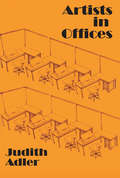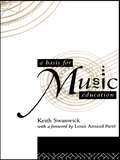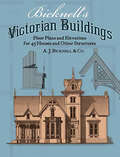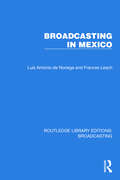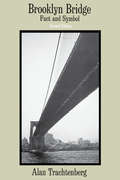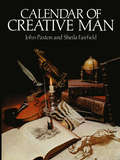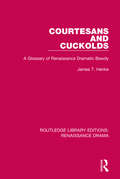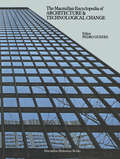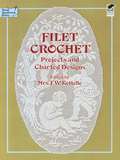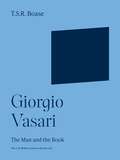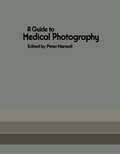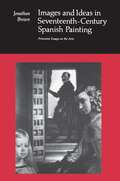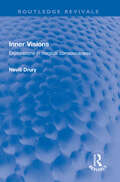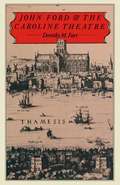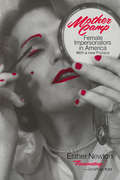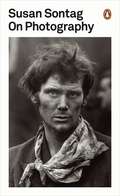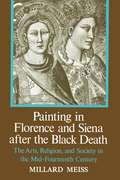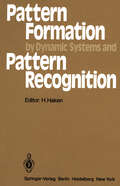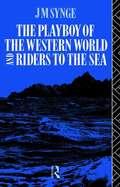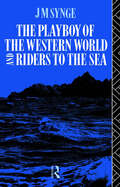- Table View
- List View
Artists in Offices: An Ethnography of an Academic Art Scene
by Judith E. AdlerUniversities have become important sources of patronage and professional artistic preparation. With the growing academization of art instruction, young artists are increasingly socialized in bureaucratic settings, and mature artists find themselves working as organizational employees in an academic setting. As these artists lose the social marginality and independence associated with an earlier, more individual aesthetic production, much cultural mythology about work in the arts becomes obsolete.This classic ethnography, based on fieldwork and interviews carried out at the California Institute of the Arts in the 1980s, analyzes the day-to-day life of an organization devoted to work in the arts. It charts the rise and demise of a particular academic art "scene," an occupational utopian community that recruited its members by promising them an ideal work setting.Now available in paperback, it offers insight into the worlds of art and education, and how they interact in particular settings. The nature of career experience in the arts, in particular its temporal structure, makes these occupations particularly receptive to utopian thought. The occupational utopia that served as a recruitment myth for the particular organization under scrutiny is examined for what it reveals about the otherwise unexpressed impulses of the work world.
A Basis for Music Education
by Keith SwanwickFirst Published in 1979. Routledge is an imprint of Taylor & Francis, an informa company.
A Basis for Music Education
by Keith SwanwickFirst Published in 1979. Routledge is an imprint of Taylor & Francis, an informa company.
Bicknell's Victorian Buildings: Floor Plans and Elevations for 45 Houses and Other Structures
by A. J. BicknellBy the 1880's, American architecture had turned to a heavily formal, almost grandiose style, forsaking the more delicate ornamentation and graceful line of the previous decade. Just prior to the shift, A. J. Bicknell & Co. published a handsome volume of contemporary designs, plans and specifications for a wide range of public and private buildings from many parts of America. Their intention was to feature a complete village which could be constructed at moderate cost; in fact they published one of the last inclusive documentations of that style of mixed Gothic, Romanesque and classical cornices, pedestals, spires and gables known as "Victorian."Forty-five buildings of all sorts -- cottages, villas, suburban houses, town houses, a farm, a jail, courthouses, banks, store fronts, churches, schools, even stables -- are portrayed in beautiful architectural drawings of scaled elevations and floor plans. Large-sized details show the principal corners, panels, railings, arches, finials, window and verandah sections; scales range from 3/32 of an inch to the foot for the elevations, to 1/2"/1' for the details.The designs come from architects in Boston, Philadelphia, Chicago, St. Louis, Nashville, and were built in many large and small communities. Along with the private homes and standard public buildings, there are plans for the first completely fireproof courthouse (built of marble and cast iron) in the United States, at Macoupin County, Illinois; the Bay County Courthouse in Bay City, Michigan, may also be numbered among the noteworthy inclusions. A three-story home in this book, with four bedrooms, dining room, kitchen, parlor, verandah, hall, portico, and cellar (with servants' quarters, if necessary) cost, at that time, $5000 to build; a series of specifications, both general and particular (for carpenters, plumbers, painters and masons) and sample contracts (with provisions for bad weather and striking workmen) offer some idea how such buildings were possible at such prices.The detailed measurements and specifications provide modellers, miniaturists, set designers, woodworkers, or even full-scale builders, with the information necessary to recreate these designs. Historians of architecture, home restorers, anyone who delights in the felicities of American Victorian, will find this book a superb primary source of authentic building style.
Broadcasting in Mexico (Routledge Library Editions: Broadcasting #15)
by Luis Antonio de Noriega Frances LeachBroadcasting in Mexico (1979) traces the birth and growth of Mexico’s broadcasting services against the background of its geographical, cultural, demographic, economic and political structure. The development of Mexican radio and television has been characterised by innovation and experiment by both government and private enterprise, and sometimes the country has been the beneficiary of these efforts and sometimes the victim. Up to a certain point, the cultural infrastructure of the country itself dictated the path taken by the media, although there have been temptations to imitate the established structure of other countries.
Broadcasting in Mexico (Routledge Library Editions: Broadcasting #15)
by Luis Antonio de Noriega Frances LeachBroadcasting in Mexico (1979) traces the birth and growth of Mexico’s broadcasting services against the background of its geographical, cultural, demographic, economic and political structure. The development of Mexican radio and television has been characterised by innovation and experiment by both government and private enterprise, and sometimes the country has been the beneficiary of these efforts and sometimes the victim. Up to a certain point, the cultural infrastructure of the country itself dictated the path taken by the media, although there have been temptations to imitate the established structure of other countries.
Brooklyn Bridge: Fact and Symbol
by Alan TrachtenbergFourteen of Walker Evans's evocative photographs of Brooklyn Bridge, most of which have never been published, appear in this edition of Alan Trachenberg's Brooklyn Bridge: Fact and Symbol. In the new afterword Trachenberg explores the history of Hart Crane's The Bridge, especially the poem's integral relationship with the powerful photography of Evans. "[Brooklyn Bridge] is familiar in so many movies, in so many stage sets and, as Mr. Trachtenberg shows in this brilliant . . . book, it is at least as much a symbol as a reality. . . . Mr. Trachtenberg is always exciting and illuminating."—Times Literary Supplement "The book is a skillful and insightful synthesis of materials about Brooklyn Bridge from such diverse fields as history, engineering, literature and art. Essentially it asks the question of why Brooklyn Bridge achieved such great impact on the nineteenth century American imagination and why it has continued to have a significant impact on twentieth century art and literature. In addition to its exploration of the bridge's symbolic significance, which includes perceptive analyses of such particular works as Hart Crane's great poem cycle and the paintings of artists like Joseph Stella, the book also includes a solidly researched account of the conception, planning and construction of the bridge. Trachtenberg's account of the intellectual and cultural sources of the bridge is particularly fascinating in its demonstration of the convergence of many different philosophical and ideological currents of the time around this great engineering enterprise, illustrating as effectively as any discussion I know the complex interplay of ideas and material culture."—John G. Cawelti, University of Chicago "Alan Trachtenberg's Brooklyn Bridge is a fascinating story, the philosophic genesis of the idea in Europe, John Roebling's heroic effort to translate it into masonry and steel, and the meanings that Americans attached to the physical object as an emblem of their aspirations."—Leo Marx, Amherst College, author of The Machine in the Garden
Courtesans and Cuckolds: A Glossary of Renaissance Dramatic Bawdy (Routledge Library Editions: Renaissance Drama)
by James T. HenkeThis title, first published in 1979, is a glossary of the bawdy vocabulary that was used in Renaissance Drama. One of the primary functions of this gloss of literary bawdy is to interpret imaginative uses of the language rather than simply record the generally accepted uses and meanings, with its principal task to make the dialogue of the plays more intelligible to the reader. With examples of bawdy language used in the works of Shakespeare, Ben Jonson and John Webster amongst many others, this title will be of great interest to students of literature and performance studies.
Courtesans and Cuckolds: A Glossary of Renaissance Dramatic Bawdy (Routledge Library Editions: Renaissance Drama)
by James T. HenkeThis title, first published in 1979, is a glossary of the bawdy vocabulary that was used in Renaissance Drama. One of the primary functions of this gloss of literary bawdy is to interpret imaginative uses of the language rather than simply record the generally accepted uses and meanings, with its principal task to make the dialogue of the plays more intelligible to the reader. With examples of bawdy language used in the works of Shakespeare, Ben Jonson and John Webster amongst many others, this title will be of great interest to students of literature and performance studies.
Filet Crochet: Projects and Charted Designs (Dover Knitting, Crochet, Tatting, Lace Ser.)
by F. KettelleFilet crochet is a simple method of producing beautiful lace by crocheting closed and open squares.This book includes complete instructions for working the squares plus tables, materials, and charts for over fifty projects such as doilies, table cloths, a lampshade, centerpieces, borders and insertions, panels for pillows and bedspreads, baby items, a tray, coffee cloths, and luncheon cloths.Each pattern has a photographs of the finished article, close-up photos of detail work, indications of the amount of thread, and the size of the crochet hook to use.|Crocheters will welcome this unique collection of hard-to-find patterns. They can be used as is, in combination, or as a source to develop your own unique ideas. The charts can be used for cross-stitching, latch-hooking, knitting, or any other forms of counted thread embroidery.
Giorgio Vasari: The Man and the Book (The A. W. Mellon Lectures in the Fine Arts #20)
by Thomas Sherrer BoaseA striking account of Vasari’s career, friendships, and contribution to the art of the Italian RenaissanceVasari’s Lives of the Most Excellent Architects, Painters, and Sculptors, first published in 1550, fixed for three hundred years general European views about the art of the Renaissance, and its influence still lingers today. While much has been written about Vasari’s writings, comparatively few full-length studies have dealt with the man himself. In this book, T.S.R. Boase offers a compelling account of Vasari’s life and career. At the same time, Boase explores Vasari’s ideas about the art and artists he described in the two editions of his Lives, placing these reflections in their contemporary context and later developments in art history and criticism. The result is an important appraisal of Vasari’s achievement, which despite its imperfections is without parallel in the history of Western art.
A Guide to Medical Photography
by Peter HansellThe entire practice of medical photography and medical The text has wisely been shorn of details that are to be illustration as we know it today may be said to have been found in general photographic textbooks. Instead it leads pioneered over the last quarter of a century. During this the reader to consider in broad terms not only the special span much progress has been made in the establishment techniques peculiar to the subject, but also to accept of standards, qualifications and codes of practice in one lessons that are available for the taking from other estab country or another, but by virtue of the compact nature of lished spheres of photography. It attempts to be an in the specialty few authoritative texts on the subject have tensely practical book and at all times the would-be emerged. practitioner is encouraged to experiment with the object This entirely new collective work, coming in the first in of developing his own techniques and general approach stance from Europe in translation, but containing addi to the subject. All this is reinforced by a wealth of specially tional contributions from the United Kingdom and the prepared diagrams to illustrate set-ups and lighting tech United States of America, must be welcome in these niques as well as carefully posed examples of a variety of changing times to those embarking on medical photog clinical material, mostly in full colour.
Images and Ideas in Seventeenth-Century Spanish Painting (Princeton Essays on the Arts #1)
by Jonathan BrownArt historians have often minimized the variety and complexity of seventeenth-century Spanish painting by concentrating on individual artists and their works and by stressing discovery of new information rather than interpretation. As a consequence, the painter emerges in isolation from the forces that shaped his work. Jonathan Brown offers another approach to the subject by relating important Spanish Baroque paintings and painters to their cultural milieu.A critical survey of the historiography of seventeenth-century Spanish painting introduces this two-part collection of essays. Part One provides the most detailed study to date of the artistic-literary academy of Francisco Pacheco, and Part Two contains original studies of four major painters and their works: Las Meninas of Velázquez, Zurbarán's decoration of the sacristy at Guadalupe, and the work by Murillo and Valdés Leal for the Brotherhood of Charity, Seville. The essays are unified by the author's intention to show how the artists interacted with and responded to the prevailing social, theological, and historical currents of the time. While this contextual approach is not uncommon in the study of European art, it is newly applied here to restore some of the diversity and substance that Spanish Baroque painting originally possessed.
Inner Visions: Explorations in magical consciousness (Routledge Revivals)
by Nevill DruryFirst published in 1979, Inner Visions discussion the nature of contemporary magical thought – encompassing the Tarot and the Qabalah – and considers its impact on the creative imagination. The author presents a fusion of the creative, magical and mythological undercurrents which are part of the ‘new consciousness’, and traces the influence of surrealist art and the expansive psychedelic period on the art and music of the 1970s. He looks, for example, at the relationship of the fantasy art on record sleeves to the electronic inner-space music which it often accompanies, and shows that this form of modern music represents one facet of the contemporary reaction against scientism and of the search for what Roszak has termed the visionary sources of our culture. The author concludes that a major mythological impulse is emerging in our culture and that magical and surreal approaches represent a profoundly invigorating and inspiring attitude linking the individual to the cosmos. This will be a fascinating read for anyone interested in magic, mythology, art, music and literature.
Inner Visions: Explorations in magical consciousness (Routledge Revivals)
by Nevill DruryFirst published in 1979, Inner Visions discussion the nature of contemporary magical thought – encompassing the Tarot and the Qabalah – and considers its impact on the creative imagination. The author presents a fusion of the creative, magical and mythological undercurrents which are part of the ‘new consciousness’, and traces the influence of surrealist art and the expansive psychedelic period on the art and music of the 1970s. He looks, for example, at the relationship of the fantasy art on record sleeves to the electronic inner-space music which it often accompanies, and shows that this form of modern music represents one facet of the contemporary reaction against scientism and of the search for what Roszak has termed the visionary sources of our culture. The author concludes that a major mythological impulse is emerging in our culture and that magical and surreal approaches represent a profoundly invigorating and inspiring attitude linking the individual to the cosmos. This will be a fascinating read for anyone interested in magic, mythology, art, music and literature.
Mother Camp: Female Impersonators in America
by Esther NewtonFor two years Ester Newton did field research in the world of drag queens—homosexual men who make a living impersonating women. Newton spent time in the noisy bars, the chaotic dressing rooms, and the cheap apartments and hotels that make up the lives of drag queens, interviewing informants whose trust she had earned and compiling a lively, first-hand ethnographic account of the culture of female impersonators. Mother Camp explores the distinctions that drag queens make among themselves as performers, the various kinds of night clubs and acts they depend on for a living, and the social organization of their work. A major part of the book deals with the symbolic geography of male and female styles, as enacted in the homosexual concept of "drag" (sex role transformation) and "camp," an important humor system cultivated by the drag queens themselves. "Newton's fascinating book shows how study of the extraordinary can brilliantly illuminate the ordinary—that social-sexual division of personality, appearance, and activity we usually take for granted."—Jonathan Katz, author of Gay American History "A trenchant statement of the social force and arbitrary nature of gender roles."—Martin S. Weinberg, Contemporary Sociology
On Photography: Essays Of The 1960s And 70s - Against Interpretation; Styles Of Radical Will; On Photography; Illness As Metaphor; Uncollected Essays (Penguin Modern Classics)
by Susan SontagSusan Sontag's On Photography is a seminal and groundbreaking work on the subject.Susan Sontag's groundbreaking critique of photography asks forceful questions about the moral and aesthetic issues surrounding this art form. Photographs are everywhere, and the 'insatiability of the photographing eye' has profoundly altered our relationship with the world. Photographs have the power to shock, idealize or seduce, they create a sense of nostalgia and act as a memorial, and they can be used as evidence against us or to identify us. In these six incisive essays, Sontag examines the ways in which we use these omnipresent images to manufacture a sense of reality and authority in our lives.'Sontag offers enough food for thought to satisfy the most intellectual of appetites'The Times'A brilliant analysis of the profound changes photographic images have made in our way of looking at the world, and at ourselves'Washington Post'The most original and illuminating study of the subject'New YorkerOne of America's best-known and most admired writers, Susan Sontag was also a leading commentator on contemporary culture until her death in December 2004. Her books include four novels and numerous works of non-fiction, among them Regarding the Pain of Others, On Photography, Illness as Metaphor, At the Same Time, Against Interpretation and Other Essays and Reborn: Early Diaries 1947-1963, all of which are published by Penguin. A further eight books, including the collections of essays Under the Sign of Saturn and Where the Stress Falls, and the novels The Volcano Lover and The Benefactor, are available from Penguin Modern Classics.
Painting in Florence and Siena after the Black Death
by Millard MeissThe first extended study of the painting of Florence and Siena in the later 14th century, this book presents a rich interweaving of considerations of connoisseurship, style, iconography, cultural and social background, and historical events.
Pattern Formation by Dynamic Systems and Pattern Recognition: Proceedings of the International Symposium on Synergetics at Schloß Elmau, Bavaria, April 30 – May 5, 1979 (Springer Series in Synergetics #5)
by Hermann HakenThis book contains the manuscripts of the papers delivered at the International Sym posium on Synergetics held at SchloB Elmau, Bavaria, Germany, from April 30 until May 5, 1979. This conference followed several previous ones (Elmau 1972, Sicily 1974, Elmau 1977). This time the subject of the symposium was "pattern formation by dynam ic systems and pattern recognition". The meeting brought together scientists from such diverse fields as mathematics, physics, chemistry, biology, history as well as experts in the fields of pattern recognition and associative memory. When I started this type of conference in 1972 it appeared to be a daring enter prise. Indeed, we began to explore virgin land of science: the systematic study of cooperative effects in physical systems far from equi~ibrium and in other disciplines. Though these meetings were attended by scientists from quite different disciplines, a basic concept and even a common language were found from the very beginning. The idea that there exist profound analogies in the behaviour of large classes of complex systems, though the systems themselves may be quite different, proved to be most fruitful. I was delighted to see that over the past one or two years quite similar conferences were now held in various places allover the world. The inclusion of prob lems of pattern recognition at the present meeting is a novel feature, however.
Playboy of the Western World
by J.M SyngeFirst published in 1979. Routledge is an imprint of Taylor & Francis, an informa company.
Playboy of the Western World
by J.M SyngeFirst published in 1979. Routledge is an imprint of Taylor & Francis, an informa company.
Robert Maillart's Bridges: The Art of Engineering
by David P. BillingtonThe description for this book, Robert Maillart's Bridges: The Art of Engineering, will be forthcoming.
